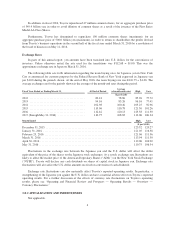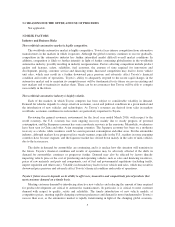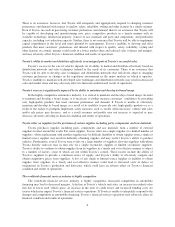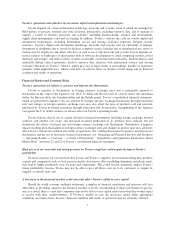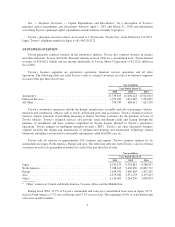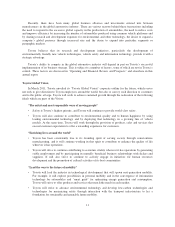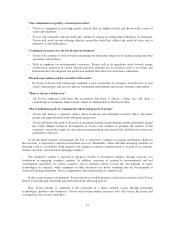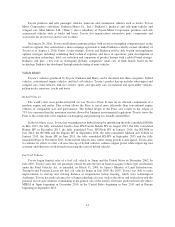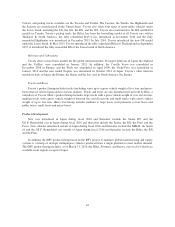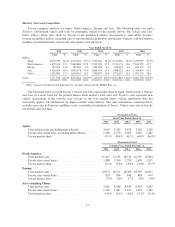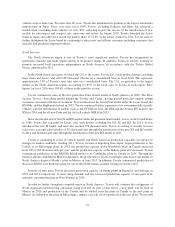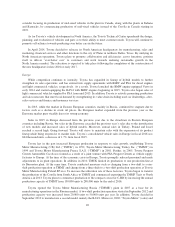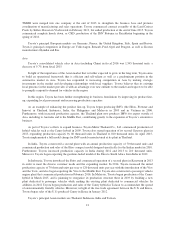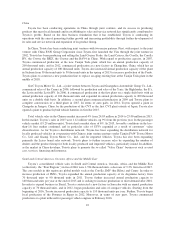Toyota 2015 Annual Report Download - page 19
Download and view the complete annual report
Please find page 19 of the 2015 Toyota annual report below. You can navigate through the pages in the report by either clicking on the pages listed below, or by using the keyword search tool below to find specific information within the annual report.Toyota produces and sells passenger vehicles, minivans and commercial vehicles such as trucks. Toyota
Motor Corporation’s subsidiary, Daihatsu Motor Co., Ltd. (“Daihatsu”), produces and sells mini-vehicles and
compact cars. Hino Motors, Ltd. (“Hino”), also a subsidiary of Toyota Motor Corporation, produces and sells
commercial vehicles such as trucks and buses. Toyota also manufactures automotive parts, components and
accessories for its own use and for sale to others.
On January 29, 2016, Toyota and Daihatsu announced that, with an aim to strengthen competitiveness in the
small car segment, they entered into a share exchange agreement to make Daihatsu a wholly-owned subsidiary of
Toyota as of August 1, 2016. Under a joint strategy, Toyota and Daihatsu will be able to plan and implement
optimal strategies including combining their technical expertise and bases of operations, joint development of
next-generation technology, bold cost reduction and expansion of product lineups with a global brand strategy.
Daihatsu will play a key role in developing globally competitive small cars of both brands based on the
technology Daihatsu has developed through manufacturing of mini-vehicles.
Vehicle Models
Toyota’s vehicles (produced by Toyota, Daihatsu and Hino) can be classified into three categories: hybrid
vehicles, conventional engine vehicles, and fuel cell vehicles. Toyota’s product line-up includes subcompact and
compact cars, mini-vehicles, mid-size, luxury, sports and specialty cars, recreational and sport-utility vehicles,
pickup trucks, minivans, trucks and buses.
Hybrid Vehicles
The world’s first mass-produced hybrid car was Toyota’s Prius. It runs on an efficient combination of a
gasoline engine and motor. This system allows the Prius to travel more efficiently than conventional engine
vehicles of comparable size and performance. The hybrid design of the Prius also results in the output of
75% less emission than the maximum amount allowed by Japanese environmental regulations. Toyota views the
Prius as the cornerstone of its emphasis on designing and producing eco-friendly automobiles.
In the last three years, Toyota has strengthened its hybrid lineup by introducing the fully remodeled IS300h
in May 2013, the fully remodeled Corolla Axio HV/Corolla Fielder HV in August 2013, the fully remodeled
Harrier HV in December 2013, the fully remodeled Voxy HV/Noah HV in January 2014, the NX300h in
July 2014, the RC300h and the Esquire HV in September 2014, the fully remodeled Alphard and Vellfire in
January 2015, the Sienta HV in June 2015, the fully remodeled RX-HV in September 2015 and the fully
remodeled Prius in November 2015. In the hybrid vehicles area, where strong growth is anticipated, Toyota aims
to continue its efforts to offer a diverse line-up of hybrid vehicles, enhance engine power while improving fuel
economy and otherwise work towards increasing the sales of hybrid vehicles.
Fuel Cell Vehicles
Toyota began limited sales of a fuel cell vehicle in Japan and the United States in December 2002. In
June 2005, Toyota’s new fuel cell passenger vehicle became the first in Japan to acquire vehicle type certification
under the Road Vehicles Act, as amended, on March 31, 2005, by Japan’s Ministry of Land, Infrastructure,
Transport and Tourism. Leases for fuel cell vehicles began in July 2005. By 2007, Toyota was able to make
improvements to start-up and cruising distance at temperatures below freezing, which were technological
challenges. Toyota has made advances by solving technological issues such as the above and worked towards the
practical use of such solutions, culminating in the general sale of the world’s first mass produced fuel cell vehicle
MIRAI in Japan beginning in December 2014, in the United States beginning in June 2015 and in Europe
beginning in September 2015.
14


